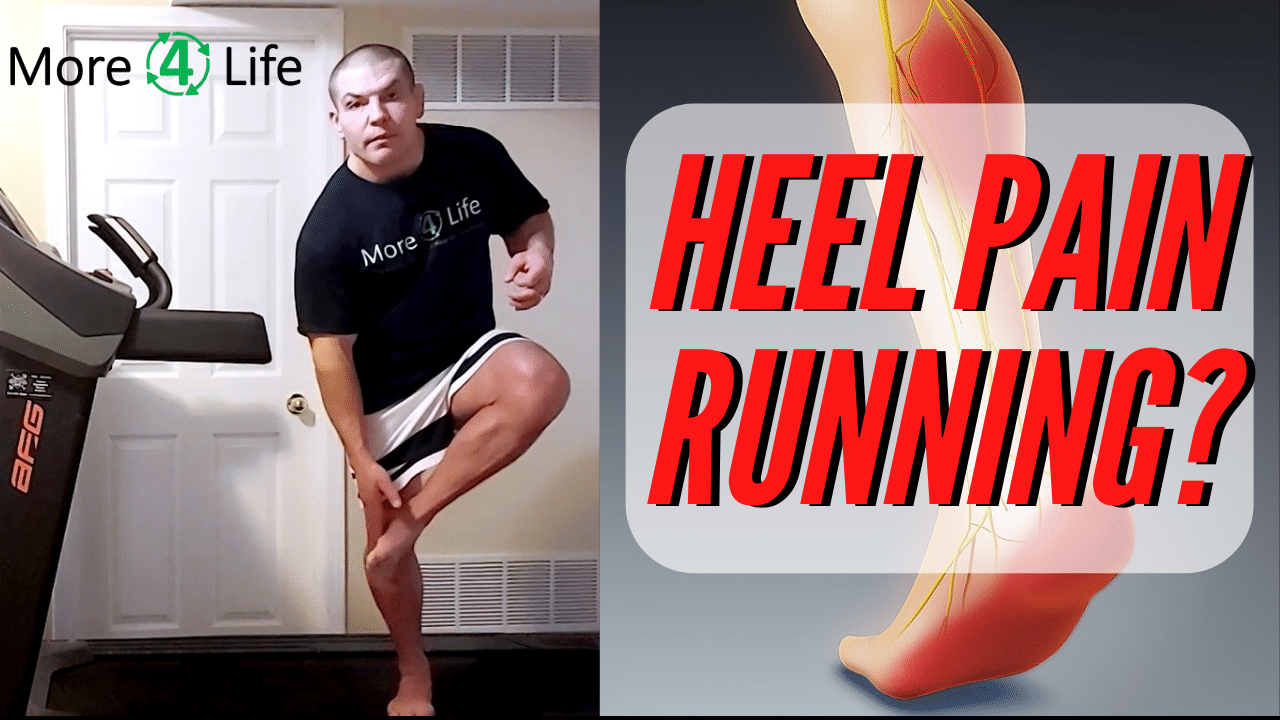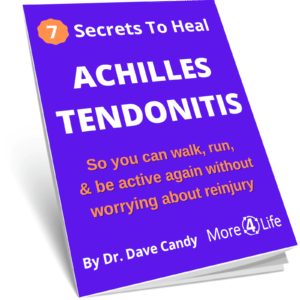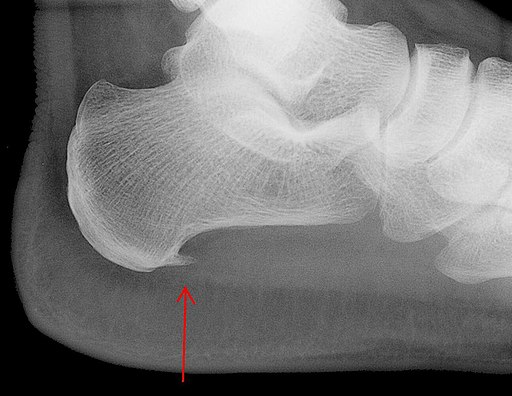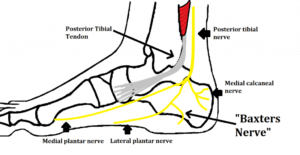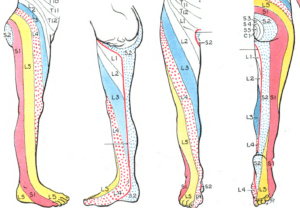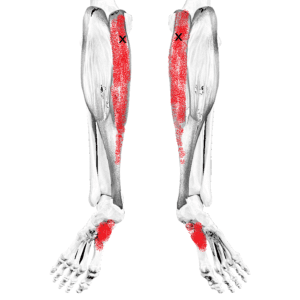Do You Get Heel Pain When Running?
Watch the video to learn 10 causes of heel pain when running plus how to relieve them.
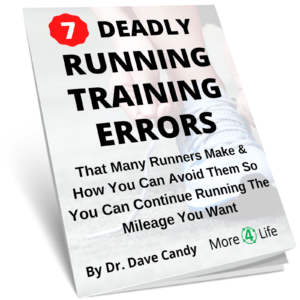
10 Causes Of Heel Pain Running
There are many things that can cause heel pain when running. Furthermore, when people refer to "heel pain" they sometimes mean different things.
For example, some people mean pain on the back of the heel by the Achilles tendon while other people mean pain on the bottom of the heel.
Here are 10 possible causes of heel pain when running:
- Plantar fasciitis
- Achilles tendinopathy
- Stress fracture
- Heel Spur
- Tarsal Tunnel Syndrome
- Medial Calcaneal Nerve
- Baxter's Nerve
- Lateral Calcaneal Nerve
- Sural Nerve
- Lower Back Referred Pain (L5-S2)
Heel Pain From Plantar Fasciitis
The plantar fascia is a broad tendon on the bottom of the foot that attaches to the heel bone, or calcaneus (see below).
Abnormal forces applied to the plantar fascia when walking or running can tug on the insertion point, causing heel pain or in some cases a bone spur.
When you have either a high arch foot that's too stiff, or your foot overpronates, you can irritate the plantar fascia, causing it to get inflamed (-itis ="inflammation"). That in turn can cause heel pain when running.
To learn more about plantar fasciitis and how to solve it, download a free copy of our Plantar Fasciitis Guide below.

Heel Pain From Achilles Tendinopathy
Achilles tendinitis refers to an inflammation of the Achilles tendon that attaches the calf muscles to the heel.
However, most Achilles problems aren't actually inflammatory, and are more properly called Achilles tendinopathy.
Achilles tendinopathy is an overuse injury, and it can cause problems in the middle of the tendon, or at the insertion on the heel.
This aptly named "insertional Achilles tendinopathy" is a common cause of heel pain when running.
However, unlike plantar fasciitis, Achilles tendinopathy causes pain on the back of the heel.
Learn more differences in my post Achilles Tendonitis vs Plantar Fasciitis.
So basically, heel pain on the back of the heel is from Achilles tendinopathy and pain on the bottom of the heel is from plantar fasciitis?
It's not quite that simple.
There are several other things that can cause heel pain when running
What Else Can Cause Heel Pain When Running?
Stress Fracture
Stress fractures are micro traumas to a bone. Often you won't be able to see stress fractures on an x-ray, so it may take awhile to diagnose them.
You can get stress fractures in any bone. However, the bottom of the heel is a common place for runners to get a stress fracture.
Common causes of stress fractures are:
- overtraining
- poorly fit shoes or shoes that are too old
- overstriding (too long of steps)
- running with a heel strike
Heel Spurs
Heel spurs are an excess buildup of bone on the bottom of the heel at the insertion of the plantar fasciia. They can happen at the back of the heel as well at the insertion of the Achilles tendon.
Heel spurs are often caused by excessive stress or tension at the attachment site of a tendon. In turn, this pulls on the periosteum around the bone and stimulates the bone to lay down more bone.
Heel spurs aren't always painful though, and many people can have them without having pain. Many people are able to exercise with heel spurs.
So just because there's a heel spur on your x-ray and you also have pain doesn't necessarily mean that it's the cause of your pain.
Furthermore, in order to get rid of it, you need to correct the muscle imbalance that caused the tendon to pull on the bone in the first place.
I'll go over how to do that a little later in this post.
Tarsal Tunnel Syndrome
Tarsal tunnel syndrome is an irritation of the tibial nerve as it passes behind the inner ankle. Tarsal tunnel syndrome can cause heel pain, foot pain, or numbness in the toes.
The path of the posterior tibial nerve is shown in the picture below. You'll notice it has several branches, two of which go to the inside of the heel. I'll discuss those causes of heel pain running further below.
Medial Calcaneal Nerve Pain
One branch of the tibial nerve, the medial calcaneal nerve, goes to the inner side of the heel and can be mistaken for insertional Achilles tendinopathy at times.
Baxter's Nerve
The medial and lateral plantar nerves are branches of the tibial nerve that go into the arch of the foot. Problems with these nerves can commonly be mistaken for plantar fasciitis. However, the first branch of the lateral plantar nerve, also known as Baxter's nerve, goes to the inside of the heel.
Sural Nerve Pain
The sural nerve is a nerve formed by branches of the tibial and fibular nerves. It runs right next to the Achilles tendon. Sural nerve problems are a source of outer heel pain when running that can often be mistaken for Achilles tendinitis due to it's proximity.
Lateral Calcaneal Nerve Pain
The lateral calcaneal nerve is a branch of the sural that goes to the inside outside of the heel.
Just as the tibial nerve and it's branches on the inner heel are often caused by overpronation, sural nerve and lateral calcaneal nerve problems often present in people who don't pronate enough.
Heel Pain From Lower Back Nerve Roots (L5-S2)
The nerve roots from the lower back can cause referred pain into the heel especially the L5, S1, and S2 nerve roots.
Attribution: Modified from Grant, John Charles Boileau, Public domain, via Wikimedia Commons
Often this type of foot pain occurs along with back pain and/or sciatica, but many times people don't connect their foot pain with their back pain or sciatica.
Keep in mind that when you're running, that causes a lot of vertical compression on your spine.
Additionally, if you overstride and/or have stiff hip flexors, that can cause excessive extension in your spine when running.
So those are 10 causes of heel pain when running
Overwhelmed Yet?
Understanding what's causing your heel pain can be difficult enough, let alone figuring out how to get it to go away.
Need Help For Heel Pain When Running?
If you'd like to get back to running your normal mileage without being bothered by heel pain tap the button below to request a Back To Running Evaluation with one of our specialists.
How To Get Rid Of Heel Pain Running
The the best way to get rid of heel pain when running is to get help from a physical therapist who is familiar with running injuries.
As noted above, there are many different causes of heel pain when running. Additionally, each person is different and requires a unique treatment approach specific to them.
However, if you're just looking for some quick tips, here are a few general tips that work for many people. As a word of caution though, don't use these tips as a substitute for getting profession treatment for your heel pain.
Stretch Your Calves
Stiff calves are common to many types of heel pain when running. Actually, trigger points in your calves can be an additional cause of heel pain when running that wasn't mentioned above.
However, you can see from the image above how trigger points in your calves can directly cause heel pain.
In addition, stiff calves cause you to overpronate when running.
Many runners already do calf stretches, but most do them wrong.
Additionally, HOW you stretch your calf muscles can make a big difference. However, many people stretch their calf muscles WRONG.
Click here to learn how to stretch your calf muscles correctly.
Rolling Your Calves
Since trigger points in the calves can cause heel pain when running, rolling your calves using a foam roller or a muscle rolling pin can help.
Yansyi Muscle Roller Stick for Athletes ...
$9.15 ($9.15 / Count) (as of July 26, 2024 20:27 GMT -05:00 - More infoProduct prices and availability are accurate as of the date/time indicated and are subject to change. Any price and availability information displayed on [relevant Amazon Site(s), as applicable] at the time of purchase will apply to the purchase of this product.)I personally think the muscle rolling pins work better for smaller muscle group like your calves, whereas the foam rollers are better for larger muscle groups like your quadriceps and hamstrings.
Don't Overstride
When you take too long of strides when running, it promotes a heel strike pattern of running. That mean your landing directly on your heel.
This can lead to stress fractures, heel spurs, or Baxter's nerve problems.
Instead, taking shorter, quicker steps encourages more of a midfoot strike pattern of running.
Additionally, since you're not taking as long of a stride, your vertical displacement from the ground is less which decreases the ground reaction force with each step.
Don't Overtrain
Increasing your milage too quickly can cause many different types of running injuries, not just heel pain.
The general rule of thumb is not to increase your milage by more than 10% per week.
That means that if you're training or a half-marathon or a full marathon, you may need to allow 4-6 months or more to work up to the proper mileage depending on your baseline.
Proper Footwear
Runners are quick to blame everything on their shoes. It's usually not just the shoes, but they are one factor.
In general, you should change your running shoes after 500-600 miles.
Additionally, you want to make sure you're wearing the proper running shoes for your foot type.
What Kind Of Running Shoes Should I Wear For Heel Pain?
There's no one best type of running shoes for all kinds of heel pain. The best running shoe for you depends on your foot type as well as how much your foot pronates when running.
In general, running shoes fall into one of 3 different categories:
- Motion-control shoes
- Stability shoes
- Neutral Shoes
Motion Control Running Shoes
Motion-control shoes, as the name suggests controls pronation of the foot They are good for severe overpronators.
Some examples of motion-control running shoes are the Saucony Omni 20
and the Brooks Adrenaline GTS 19 Running Shoe
Stability Running Shoes
If you have flat feet that moderately overpronate when running, you probably need a stability shoe.
Stability shoes give a moderate amount of pronation control while being a little lighter than motion control shoes. Stability shoes are good for moderate overpronators.
Some examples of stability shoes are the Saucony Guide 14 Running Shoe
or the Brooks Launch GTS 9 Supportive Running Shoe
Neutral Running Shoes
Neutral running shoes don't control pronation. They are designed to keep the foot in a neutral position while providing cushioning and shock absorption. Neutral shoes are good for people with high arch feet or people who overly supinate when running.
Some examples of neutral running shoes are the Saucony Women's Endorphin Pro Running Shoe
or the Brooks Launch 8 Neutral Running Shoe
Do Orthotics Help Heel Pain When Running?
Over-the-counter insoles and custom orthotics can help decrease heel pain when running.
Generally, orthotics work by preventing overpronation when running.
However, people with a high arch foot may need a more flexible insole or orthotic.
Spenco Insoles For High Arches are one example of such an insole.
Typically, custom orthotics will have a greater impact on decreasing your foot pain because they are built specifically to the configuration and shape of your foot.
Want To Find Out How To Relieve Heel Pain Faster?
If you'd like to get back to running quickly, tap the button below to request a Back To Running Evaluation

